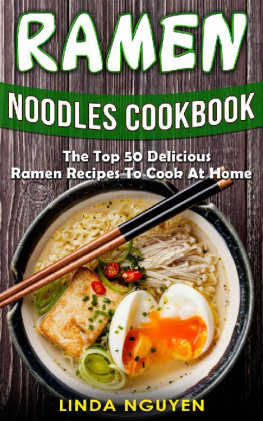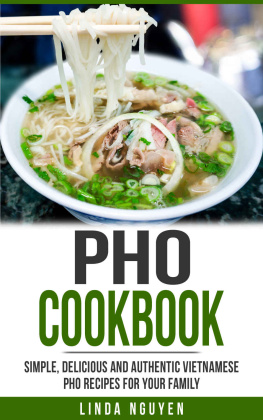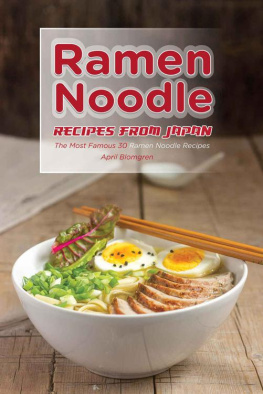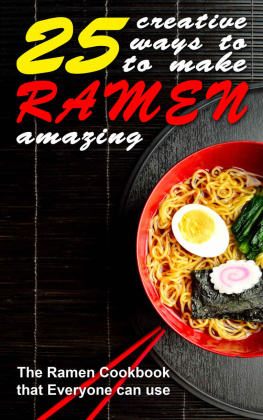Ramen Noodles
The Top 50 Simple and Delicious Ramen Recipes to Cook at Home

Great Books Change Life
TABLE OF CONTENTS
Copyright 2018 by Dingo Publishing - All rights reserved.
The contents of this book may not be reproduced, duplicated or transmitted without direct written permission from the author.
Under no circumstances will any legal responsibility or blame be held against the publisher for any reparation, damages, or monetary loss due to the information herein, either directly or indirectly.
Legal Notice:
You cannot amend, distribute, sell, use, quote or paraphrase any part or the content within this book without the consent of the author.
Disclaimer Notice:
Please note the information contained within this document is for educational and entertainment purposes only. No warranties of any kind are expressed or implied. Readers acknowledge that the author is not engaging in the rendering of legal, financial, medical or professional advice. Please consult a licensed professional before attempting any techniques outlined in this book.
By reading this document, the reader agrees that under no circumstances is the author responsible for any losses, direct or indirect, which are incurred as a result of the use of information contained within this document, including, but not limited to, errors, omissions, or inaccuracies.
Introduction
I want to thank you and congratulate you for choosing this book, Ramen Noodles: The top 50 simple and delicious Ramen recipes to cook at home.
People become nostalgic when they hear someone mention Ramen noodles. Most young people have wonderful memories of surviving on the little packets of noodles and seasoning when they tried to make ends meet on an entry-level paycheck or when they were in college. For those who are budget conscious, these packaged noodles were the perfect food for the following reasons: cheap, filling and fast (they cook in 3 minutes!).
It is true that the broth and freeze-dried vegetables can get boring after some time and the sodium filled seasoning does not help either. That is where this book comes in. You can take advantage of the low priced, convenient and fast cooking time of the instant Ramen noodles packet or you could use your own sauces, seasonings and ingredients to create many dishes. Delicious soups, vegetable stir-fries, casseroles, burgers, salads and more can all be made using these Ramen noodles. Since noodles are often a part of the culinary experience, dishes made using Ramen noodles can be a definite conversation starter.
Stock up on the little packets of Ramen noodles, because you will find 50 different ways to use those noodles to prepare instant, delicious dishes you never dreamed you could cook!
So what are we waiting for, let us get started!
Thanks again for purchasing this book. I hope you enjoy it!
Chapter One: Ramen: A Brief History
The words Japanese Ramen must ring bells in the minds of numerous college students. It makes us recall the days when we would satisfy our midnight cravings by quickly cooking Ramen noodles. For a minimal amount of money, we could purchase a Styrofoam cup filled with Ramen noodles that could be cooked in a microwave in about 2 minutes. Even though we were advised by our parents not to consume large quantities of packaged foods, Ramen was the one-thing college students could not walk away from. Even though there were many suspicious preservatives used, students would consume them almost daily. It was cheap and easy to make. This is obviously not the original Japanese Ramen, but it is the first thing that comes to mind when we hear those words.
Traditionally, in its most basic form, the Japanese cooked Ramen as a noodle soup, which was filled with cut vegetables and meat. It was also sometimes cooked with fish in a thick broth with noodles. It is equivalent to a full meal in a single bowl. For a very long time now, it has been a popular street food. The key word in the first statement of this paragraph is traditional. Today, Ramen has numerous variations to it. If you were to visit Japan, you would find a different style of Ramen in nearly every region of the country. The scope for variation is massive; you can modify the broth, the spices that go into making the broth and the contents that you add to the broth like meat and vegetables.
No matter how many variations we use to make Ramen today, the one thing that stays constant is the type of noodle that is used. Soba noodles are made from wheat and have Chinese origins. Since Soba is originally from China, some people believe that Ramen must also be from China. However, the Japanese are the people who came up with the dish. The popularity of Ramen has grown so much that it could be considered the national dish of Japan (sushi is another candidate for the title). It is a fact that, around 1900, Chinese restaurants in Japan and China served dishes that were made using soba noodles. The noodles used to be sliced, as opposed to being hand pulled these days. The dishes served were essentially just soba noodles in broth topped with some meat and cut vegetables. The broth was made by boiling pork bones.
Some Chinese immigrants in Japan sold this to the Japanese on stalls that were set up on the streets. Some of these stalls could be pulled like a wheelbarrow. It was easy to make and sell Ramen. The vendors would cook the Ramen at home and bring it with them and serve it to the locals. Through the Second World War, the Chinese origin of the noodles stayed on. They were called Shina soba, which translates to Chinese wheat noodles. The street vendors who sold Shina soba would announce their arrival by blowing a special horn called the charumera. By the middle of the twentieth century, Ramen noodles had become extremely popular. Today, it is synonymous with Japanese cuisine.
After the end of World War 2, Ramen started to cross the borders of Japan into neighboring countries. After the second Sino-Japanese war, many Chinese and Japanese citizens had to move out of their countries due to widespread damage. This led to a diaspora of Chinese and Japanese people to European countries and the United States. They brought along with them their cuisine, which was little known in these parts of the world.
Ramen slowly gained popularity in these countries as well. Instant Ramen style noodles shot to fame in 1958. This was the year that Momofuku Ando, the founder of Nissin foods, invented the instant ramen. By simply adding boiling water, people could eat a bowl of noodles and soup, which was topped with meat and vegetables in a matter of minutes. The most surprising thing about this is that it was termed the most significant Japanese contribution to the 20th century by a poll conducted in 2000 in Japan. Ramen has such massive popularity that a museum dedicated solely to Ramen was opened in Yokohama in 1994.
Instead of eating instant ramen, you could cook Ramen at home itself. All you will need is some fresh noodles called Chukamen, some broth and vegetables and meat. There are three main types of broth: miso, shyoyu (soy sauce) and shio (salt). The basic broth is still made from boiling pork bones. These three options can be used to add extra flavor to the broth. Add only one of the three since all of them add the same salty flavor and adding all three would ruin the taste of the dish.
The only time-consuming part of the process of cooking Ramen is the broth. There is a shortcut, however, in that you could use bouillon cubes. However, I would still recommend using some bones and boiling them in water. You can add additional spices to the broth for flavor. People add skinned garlic cloves, sliced ginger and one of the three ingredients mentioned in the previous paragraph. Another element that is commonly used is sake. You could put in whatever you want as long as you are aware of what it tastes like.






